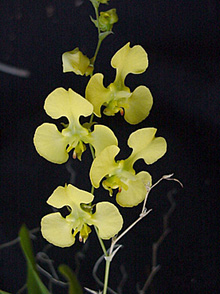
|
 |
 |
 Editorials | Environmental | January 2008 Editorials | Environmental | January 2008  
'Orchids are People, Too'
 Kathy Van Mullekom - Newport News Kathy Van Mullekom - Newport News
go to original


| | The Acineta hagsateri orchid inhabits cool humid pine-oak forests above 4000 feet in the southern Sierra Madre del Sur area of Mexico. (Weyman Bussey) | 
| | Stanhopea tigrina is an extremely fragrant Mexican orchid with flowers up to 8 inches across. (Weyman Bussey) | 
| | Erycina echinata is found rarely in the semi-arid lowlands of the Pacific coast of Mexico. (Weyman Bussey) | | |
Weyman Bussey still remembers the first orchid he saw blooming in the wild. The year was 1966, when he was 12 years old and on a camping trip in south Florida. Adults on the outing decided to take an orchid-hunting trip early one morning and insisted he go with them.

"When I saw my first Encyclia tampense, commonly called the butterfly orchid, in bloom, that was it, a moment I will never forget," he says. "It was the beginning of the last 39 years of orchid addiction."

Currently, Bussey lives in Houston, where he specializes in showy Mexican orchids. Since that memorable day in Florida, he's founded companies that commercially grow orchids on two continents. He travels the world giving programs on their care.

After seeing that initial butterfly orchid, Bussey didn't wait long to learn more about the plants. When he learned an elderly woman had an orchid-filled greenhouse near his childhood church, he skipped religious services for the next five years so he could visit her. Soon he found a greenhouse to grow his own - and he was only a ninth-grader.

In 1972, he attended the World Orchid Conference in Colombia where he fell in love with the country and its plants. He went there to live and work with orchids, eventually meeting his current wife. He's also studied and worked with orchids in California. When he's not working with or hunting orchids in Mexico, he teaches school.

Q: Why do orchids fascinate you?

A: Orchids are the largest and most highly evolved plant family on Earth. More than 35,000 species are found around the planet, on every continent except Antarctica. Their peak of diversification occurs in the tropics where they have found a suitable habitat on rocks and trees. They are easily inbred, even between genera, and more than 100,000 manmade hybrids have been officially registered with the Royal Horticultural Society.

For the most part, the plants are perennial and live at least as long as we will. They are tough plants, hard to kill with cultural excesses being their biggest enemy. Your reward for a year of care - at least one bloom.

Q: Why and how are Mexican orchids different from other orchids?

A: Mexican orchids are unique on this planet. The geographical location of Mexico creates extreme climates, and the orchids that have evolved there have found small niches in the rugged landscape where they survive and thrive. Unlike totally tropical orchids from Colombia and other equatorial countries, Mexican orchids are subjected to the four seasons, plus extended wet and dry times. They inhabit mainly creek beds and canyons in the wild. They are tough plants compared to others and more forgiving to mistreatment.

Q: What are the major mistakes people make growing orchids?

A: The first major mistake is not knowing where they come from and how they grow in nature.

The second mistake, and probably the most fatal, is giving plants too much care.

The final mistake is wanting more plants than you have room to grow.

Basically, you need to understand their WANTS - water, air, nutrition, temperature and sunlight - all of which I cover in my talks. You also have to know that orchids are people, too; think of what makes you comfortable and give that to your orchid. You have "wants" and so do they.

Q: What does an orchid "say" to you when you look at it?

A: After looking at orchids around the world for almost 40 years and growing them intensely for almost the same amount of time, all orchids tell me how happy they are by the way they look. When I actually talk to them, most say they want to come home with me. | 
 | |
 |



